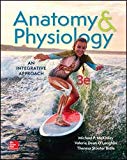
Loose Leaf For Anatomy & Physiology: An Integrative Approach
3rd Edition
ISBN: 9781260162493
Author: McKinley Dr., Michael; O'Loughlin, Valerie; Bidle, Theresa
Publisher: McGraw-Hill Education
expand_more
expand_more
format_list_bulleted
Concept explainers
Question
Chapter 22.3, Problem 11WDL
Summary Introduction
To define:
The term fever and also determine its three stages.
Concept introduction:
Fever is the abnormal elevation of body temperature, which is above
Expert Solution & Answer
Want to see the full answer?
Check out a sample textbook solution
Students have asked these similar questions
What are the physiologic changes that occur when thecause of a fever is removed?
How do drugs such as aspirin and ibuprofen act to reduce fever?
What is the mechanism by which fever is induced and what are its benefits in terms of combating an infection?
Chapter 22 Solutions
Loose Leaf For Anatomy & Physiology: An Integrative Approach
Ch. 22.1 - Prob. 1LOCh. 22.1 - Prob. 2LOCh. 22.1 - Which pathogen must enter a cell to replicate?...Ch. 22.2 - Prob. 3LOCh. 22.2 - Prob. 2WDLCh. 22.2 - Prob. 4LOCh. 22.2 - Prob. 5LOCh. 22.2 - What is the definition of a cytokine? How are...Ch. 22.2 - Prob. 6LOCh. 22.2 - Prob. 4WDL
Ch. 22.3 - Prob. 7LOCh. 22.3 - Prob. 5WDLCh. 22.3 - LEARNING OBJECTIVE
8. Describe the cells that...Ch. 22.3 - Prob. 6WDLCh. 22.3 - How do NK cells accomplish the task of eliminating...Ch. 22.3 - Prob. 9LOCh. 22.3 - Prob. 10LOCh. 22.3 - Prob. 11LOCh. 22.3 - Prob. 8WDLCh. 22.3 - Prob. 12LOCh. 22.3 - Prob. 13LOCh. 22.3 - Prob. 14LOCh. 22.3 - Prob. 1WDTCh. 22.3 - Prob. 9WDLCh. 22.3 - Prob. 10WDLCh. 22.3 - Prob. 15LOCh. 22.3 - Prob. 16LOCh. 22.3 - Prob. 11WDLCh. 22.3 - Prob. 12WDLCh. 22.4 - Prob. 17LOCh. 22.4 - Prob. 18LOCh. 22.4 - Prob. 19LOCh. 22.4 - Prob. 13WDLCh. 22.4 - What distinguishes a hapten from an antigen?Ch. 22.4 - Prob. 20LOCh. 22.4 - Prob. 2WDTCh. 22.4 - Prob. 15WDLCh. 22.4 - Prob. 21LOCh. 22.4 - LEARNING OBJECTIVE
22. Describe antigen-presenting...Ch. 22.4 - LEARNING OBJECTIVE
23. Explain the process of...Ch. 22.4 - Prob. 24LOCh. 22.4 - Which type of MHC class molecules is found on all...Ch. 22.4 - Prob. 25LOCh. 22.4 - Prob. 17WDLCh. 22.5 - Prob. 26LOCh. 22.5 - Prob. 18WDLCh. 22.5 - Prob. 27LOCh. 22.5 - Prob. 19WDLCh. 22.5 - Prob. 28LOCh. 22.5 - LEARNING OBJECTIVE
29. Describe the formation and...Ch. 22.5 - Prob. 20WDLCh. 22.6 - LEARNING OBJECTIVE
30. Describe how both helper...Ch. 22.6 - Prob. 21WDLCh. 22.6 - How do cytokines released by helper T-lymphocytes...Ch. 22.6 - LEARNING OBJECTIVE
31. Compare the activation of...Ch. 22.6 - Prob. 23WDLCh. 22.6 - Prob. 24WDLCh. 22.6 - Prob. 32LOCh. 22.6 - Prob. 25WDLCh. 22.7 - Prob. 33LOCh. 22.7 - Prob. 34LOCh. 22.7 - Prob. 35LOCh. 22.7 - Prob. 3WDTCh. 22.7 - Prob. 26WDLCh. 22.7 - Prob. 27WDLCh. 22.7 - Prob. 36LOCh. 22.7 - Prob. 37LOCh. 22.7 - Prob. 28WDLCh. 22.8 - Prob. 38LOCh. 22.8 - Prob. 29WDLCh. 22.8 - Prob. 39LOCh. 22.8 - What are the six major functions of antibodies?...Ch. 22.8 - Prob. 40LOCh. 22.8 - Which subclass of antibodies is most prevalent?...Ch. 22.9 - Prob. 41LOCh. 22.9 - Prob. 32WDLCh. 22.9 - Prob. 42LOCh. 22.9 - Prob. 33WDLCh. 22.9 - Prob. 43LOCh. 22.9 - LEARNING OBJECTIVE
44. Describe how both active...Ch. 22.9 - Prob. 34WDLCh. 22 - Prob. 1DYBCh. 22 - _____ 2. This cell releases cytokines to activate...Ch. 22 - _____ 3. This cell is activated by binding...Ch. 22 - _____ 4. These two cells destroy an infected cell...Ch. 22 - _____ 5. All of the following are functions of...Ch. 22 - Prob. 6DYBCh. 22 - _____ 7. During which process does additional...Ch. 22 - _____ 8. This chemical is released by...Ch. 22 - _____ 9. The correct sequence of the major events...Ch. 22 - Prob. 10DYBCh. 22 - Compare the general characteristics of innate...Ch. 22 - Define the inflammatory response, and explain its...Ch. 22 - Describe an antigen.Ch. 22 - Describe class I and class II MHC molecules, and...Ch. 22 - Prob. 15DYBCh. 22 - Prob. 16DYBCh. 22 - Explain the general function of cytotoxic...Ch. 22 - Describe both the function of antibodies and...Ch. 22 - There are two branches of adaptive immunity:...Ch. 22 - Prob. 20DYBCh. 22 - Prob. 1CALCh. 22 - Prob. 2CALCh. 22 - Prob. 3CALCh. 22 - Prob. 4CALCh. 22 - Prob. 5CALCh. 22 - Prob. 1CSLCh. 22 - Prob. 2CSLCh. 22 - Prob. 3CSL
Knowledge Booster
Learn more about
Need a deep-dive on the concept behind this application? Look no further. Learn more about this topic, biology and related others by exploring similar questions and additional content below.Similar questions
arrow_back_ios
SEE MORE QUESTIONS
arrow_forward_ios
Recommended textbooks for you
